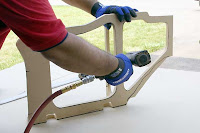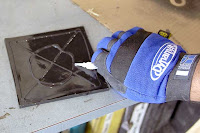The goal of this project was to build an enclosure that was completely hidden behind the factory side panel. Here is the step by step process.
Step 1: Build a frame work for the enclosure. The bottom and front panels of the enclosure are built using MDF. Save the cutouts of the front frame work for later in the build.
Step 2: Once the frame work is sized up, remove and use the front frame to trace the front baffle. Make sure to trace the inside as well as the outside
Step 3: Assemble the frame work. Notice that the cut out brace allows air flow while increasing the stiffness in the center of the enclosure.
Step 4: TacMat, placed behind the frame work, is used as the enclosure back wall. TacMat cushions and insulates the fiberglass from the vehicle, forming a non-resonant composite enclosure. This stops the squeaking noises common with fiberglass/metal contact. Once the TacMat is positioned, use a marker to trace the edges of the frame work.
Step 5: Working outside the vehicle, hot glue the TacMat to the frame. Trim to fit. Once completed, reinstall in the vehicle.
Step 6: Tape off and protect the area to fiberglass. TacMat does not require taping off the area behind. This is a great time saver. Notice how the TacMat is pulled above the frame. This will be trimmed off after the fiberglass is set.
Step 7: Fiberglass the enclosure. Make sure to pay special attention to sealing the front framework to the fiberglass and TacMat. The quality of the bond will determine the quality of the enclosure. For best results, use multiple small strips of fiberglass cloth. Build up the enclosure so that the fiberglass is approximately ¼” thick. Trim off the excess TacMat around the vehicle.
Step 8: Once the fiberglass is completely cured, remove the enclosure from the vehicle. For best results, wait 24 hours to remove the enclosure. This will ensure that the shape remains intact.
Step 9: Next apply DynaSpray (Dynamat’s liquid damping material) to the inside of the enclosure. This will further damp the fiberglass enclosure. The combination of TacMat and DynaSpray transforms the fiberglass into a non-resonant enclosure.
Step 10: Notches were placed in the front of the enclosure to clear mounting tabs for the factory panel. These holes are sealed with Kitty Hair (fiberglass strands suspended in body filler). Follow instructions on the product for best results.
Step 11: Taking the cut-outs from the front framework, adhere Dynamat Original by applying adhesive to the logo side of the product and the panels. For best results, use and upholstery grade adhesive. If you do not have access to that, you can substitute 3M Super 77.
Step 12: Remove the Dynamat Original release liner and apply to the front baffle. Use the guides you traced in Step 2 for alignment. The benefit of the double thick baffle with Dynamat Original is two fold. The thicker baffle provides an extra sturdy mounting for the woofer. By sandwiching Dynamat Original between the two MDF panels, the result is an internally damped front baffle that is extremely dead. Rapping on it with your knuckles sounds like concrete!
Here’s the look of the enclosure he so far.
Step 13: Tile DynaXorbs on the back wall of the enclosure. DynaXorbs are designed to absorb the back-wave noise and distortion of the subwoofer. The results are reduced internal enclosure reflections which enhance the sound quality of the subwoofer.
Step 14: Apply masking tape to the backside of the woofer mounting hole. This is a simply way to ensure that adhesive sprayed to the exterior of the enclosure does not get inside the enclosure. When mounting the front baffle to the enclosure, nails work fine but screws are preferred. Screws ensure a tight bond between the front baffle and enclosure.
Step 15: Cover the enclosure. Use your desired finish for your enclosure. I chose a simple trunk liner because my enclosure is hidden behind the factory side panel.
Using this construction method, I was able to construct a 1 cubic foot enclosure that hides behind the factory side panel. Resonances typical in fiberglass construction are non-existent. The enclosure is roughly half the weight as a comparable MDF enclosure. Not to mention that a enclosure this size would not have fit behind the factory panel.
This woofer is definitely heard but not seen. The JL Audio 8W7 (yes an 8 inch) is able to achieve a respectable 129dB when tuned for sound quality. With great low-frequency extension, the sound is effortless and the performance is much larger that the 8 inch woofer

























































0 comments:
Post a Comment